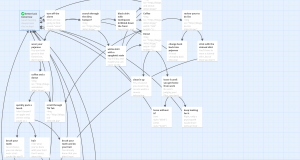
It took more hours than I care to reveal, but I’ve created my very first Twine! I don’t mind that it took me a long time, it was pleasantly frustrating and the process was as enjoyable as the product. In this game called Get out the door you’ve slept through your alarm and now you’re running late. Your job is to get through the game before 8 AM. There are a few paths to victory and several dead ends. I hope you enjoy the game and I’d be happy to hear what you think.
I’ve never used Twine before and there was indeed a learning curve. I think that one needs to have a decent level of frustration tolerance before embarking on making a product on Twine. I would imagine that the more I used the program the more efficient I would become at using it. However, for me personally, part of the joy of making the game was the problem solving aspect, not just in coming up with the idea, but in actually employing the program. Kafai (2006) discusses the importance and value not in playing games for learning, but in making games for learning. I can see how Twine would certainly support the idea of ‘making’ as learning. For instance, my peer, Ying used Twine to tell an informative procedural story. Having students use Twine to demonstrate concepts would be an excellent way to make games for learning. Twine could also help students illustrate and make explicit their thinking and understanding of topics, especially maybe for students that are challenged by showing their thoughts linearly. As Bush (1945) notes the mind works by association and connects ideas through a web of trails, so why not capitalize on that associative experience by letting our students demonstrate their thinking that way too. Again, Ying has a really great discussion of this on her page.
My process for creating my game on Twine evolved organically and was not premeditated. What ended up happening was that anytime a fork in the story was created, I would continue fully down one path before returning to the fork. In that sense, there was a linear process included in making a game with parallel narratives. Bolter (2001) writes that “all writers have had the experience of being overwhelmed with ideas as they write” (p.32) and discusses the idea that before the digital age and before printing, that there was a sense that writers were overwhelmed from within. I think that being able to use Twine to write parallel stories could ease that sense of being overwhelmed. It’s almost as every fork that was created served as a bookmark of an idea to come back to. This got me thinking about all the ways I bookmark ideas in my own life. One habit I have is having multiple tabs open on my computer of similar related ideas that I can come back to. In the last few months I have been using concepts maps. I have multiple notes in my notes apps to come back to. And sometimes I just store Ideas in my head, hoping that I’ll remember to come back to them. I appreciate hypertext in this sense, because I can use it to follow streams of consciousness (I assume we can all relate to going down a Wikipedia rabbit hole). I can see how something like hypertext would help to solve the sense of both being overwhelmed from ideas from within and overwhelmed from all the information available for us to assimilate from the outside in (Bolter, 2001).
After reading about Nelson’s (1999) Xanadu, I was surprised to see how much my Twine resembled his preliminary ideas on parallel documents. Nelson discusses the idea of parallelism between documents and the need to be able to show, visually, the connections between them in order to compare them. I had never heard of Xanadu before, and as far as I can tell it has never come to fruition, but certainly I can understand the perspective, like that of Bush (1945), of wanting to be able to find a better system for organizing all the information that is available in the world. I can also understand the desire to find a system that breaks free of the limitations of the material world.

The back end of a game created in Twine may resemble the preliminary drawings of Theodore Nelson’s (1999) Xanadu.
I’m curious, how do you keep track of your thoughts, do you feel like you think more linearly or more associatively? How do you ‘bookmark’ ideas in your day to day life?
References
Bolter, Jay David. (2001). Hypertext and the remediation of print. In Writing space: computers, hypertext, and the remediation of print. Routledge. (pp.27-46)
Bush, V. (1945). As we may think. The Atlantic Monthly, 176(1), 101-108. https://www.theatlantic.com/magazine/archive/1945/07/as-we-may-think/303881/
Kafai, Y. (2006). Playing and making games for learning: Instructionist and constructionist perspectives. Games and Culture,1(1), 36-40.
Nelson, T. (1999). Xanalogical structure, needed now more than ever: Parallel documents, deep links to content, deep versioning and deep re-use. ACM Computing Surveys, 31 (4).

Diedre I don’t know if its just me but your file link I can’t use.
Oh no! Can you tell me a bit more? Is it not opening? Did you try using chrome? Feel free to message me on mattermost if that’s easier and thank you for letting me know.
While I was learning about the Memex machine and also making my Twine, I was thinking about how I have digital sketchbooks/notebooks to keep track of my thoughts and information (currently using OneNote) but that I don’t actually use anything that allows me to create associative links. And, in fact, I don’t think I’ve ever found or tried a notebook app that allows you to make associative links. You can make a page but you can’t really link it to other pages in most apps, and I suspect this capability is not really offered because even though we may think associatively, we certainly have a hard time finding information later if it’s organized associatively. What do you think?
That’s a really interesting insight. I don’t know if there is really a one size fits all organizational scheme for finding information. I suppose all organization is associative, it’s just whether those associations are shared.
Although, I thought you could link in OneNote.